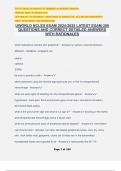TITLE: EMILLYCHARLOTTE 2024/2025 ACADEMIC PERIOD
OWNER: EMILLYCHARLOTTE
COPYRIGHT STATEMENT: ©2024 EMILLYCHARLOTTE. ALL RIGHTS RESERVED
FIRST PUBLISHED: SEPTEMBER 2024
UWORLD NCLEX EXAM 2024-2025 LATEST EXAM 300
QUESTIONS AND CORRECT DETAILED ANSWERS
WITH RATIONALES
what medications interact with grapefruit? - Answer✔️✔️-calcium channel blockers:
diltiazem, nifedipine, verapamil, etc
statins
caffeine
SSRIs
be sure to practice math! - Answer✔️✔️-
stent placement using the femoral approach puts you at risk for retroperitoneal
hemorrhage - Answer✔️✔️-
what are early signs of bleeding into the retroperitoneal space? - Answer✔️✔️-
hypotension, back pain, flank ecchymosis (grey turner sign), hematoma formation,
diminshed distal pulses
what is the grey-turner sign and what is it a sign of? - Answer✔️✔️-bruising of the flanks
and retroperitoneal hemorrhage and is a bluish color
what are some physical signs of peripheral arterial disease? - Answer✔️✔️-intermittent
calf muscle pain?, rest pain, hair loss, decreased peripheral pulses, cool, dry, shiny
skin, thick brittle nails, gangrene, ulcers (all of these are in the extremities)
transplanted hearts are expected to be - Answer✔️✔️-tachycardic like 90-110
Page 1 of 190
,TITLE: EMILLYCHARLOTTE 2024/2025 ACADEMIC PERIOD
OWNER: EMILLYCHARLOTTE
COPYRIGHT STATEMENT: ©2024 EMILLYCHARLOTTE. ALL RIGHTS RESERVED
FIRST PUBLISHED: SEPTEMBER 2024
what is the priority intervention for pain with sickle cell crisis and why? - Answer✔️✔️-
administer IV fluids to reduce blood viscosity and restore perfusion to areas affected by
vasoocclusion
what is the purpose of continuous bladder irrigation? - Answer✔️✔️-it is perscribed after
TURP to prevent obstruction of urine outflow by removing clotted blood from the bladder
what is the nurses care of monitoring CBI? - Answer✔️✔️-monitor quality of drainage,
titrate the inflow rate, and manurally irrigating as needed
characteristics of a basilar skull fracture - Answer✔️✔️-periorbital hematomas (raccoon
eyes), csf fluid rhinorrhea, and battle sign (behind the ear bruising)
immediate client care for basilar skull fracture - Answer✔️✔️-cervical spime
immobilization, close neurologic monitoring, and support of ABCs
vomiting with intake may mean - Answer✔️✔️-viral or bacterial infection
tympanosomty tubes are placed for - Answer✔️✔️-recurrent otis medias
nurse actions during a seizure - Answer✔️✔️-assist them to lie down is standing/sitting,
put them on side for patent airway, loosen tight clothing, give oxygen as needed,
remove objects from immediate area, document time and duration of seizure (for tests
are done later to see which type of seizure and maybe what exacerates it)
never put anything in mouth or restrain them since musclec ontractions can occur
during a seizure
Page 2 of 190
,TITLE: EMILLYCHARLOTTE 2024/2025 ACADEMIC PERIOD
OWNER: EMILLYCHARLOTTE
COPYRIGHT STATEMENT: ©2024 EMILLYCHARLOTTE. ALL RIGHTS RESERVED
FIRST PUBLISHED: SEPTEMBER 2024
what are some early symptoms of ICP? - Answer✔️✔️-altered LOC, headache, abnormal
reathing, rise in bp, slow pulse, vomiting
client who has a TIA is often placed on - Answer✔️✔️-prophylactic antithrombotic
treatment like aspirin or clopidogrel
glascow coma scale ranges from - Answer✔️✔️-3-15; 3 being worst 15 being best
condition (8 or below in a coma)
what are the 3 components? - Answer✔️✔️-eye opening
motor response
verbal response
what is a primary component in TPN? - Answer✔️✔️-glucose, so the nurse should be
monitoring blood glucose and be assessing for signs of hyperglycemia
when a client is on TPN, the nurse must assess for hyperglycemia why? - Answer✔️✔️-
bc a primary component is glucose. therefore the nurse must be assessing to see if the
client is getting too much glucose (hoerglycemia). and with a large urinary output like
4800, this could indicate symptoms of hyperglycemia
signs og hyperglycemia - Answer✔️✔️-polydipsia, polyuria, restless, confused, bg over
200, fatigue, kussmaul resp
what is the goal for mass casualty events? - Answer✔️✔️-do the greatest good for the
greatest number of people
keep in mind that disaster triage ranks the likelihood of survival with treatment, not
necessarily the severity of the injury - Answer✔️✔️-
Page 3 of 190
, TITLE: EMILLYCHARLOTTE 2024/2025 ACADEMIC PERIOD
OWNER: EMILLYCHARLOTTE
COPYRIGHT STATEMENT: ©2024 EMILLYCHARLOTTE. ALL RIGHTS RESERVED
FIRST PUBLISHED: SEPTEMBER 2024
what are the 4 categories for triaging? - Answer✔️✔️-immediate (red tag)- life threatening
injuries with good prognosis once treated
delayed (yellow)- injuries requiring treatment within hours
minimal (green tag)- injuries requiring treatment within a few days
expectant (black tag)- extensive injuries, poor prognosis regardless of treatment
rule of nines - Answer✔️✔️-head: 4.5 front 4.5 back
torso: 18 front 18 back
each arm: 4.5 front 4.5 back (each arm is 9 total)
each leg: 9 front 8 back (each is 18 total)
genitals: 1
extrapyramidal side effects - Answer✔️✔️-ACUTE DYSTONIC REACTION: sudden onset
sustained muscle contractions
AKATHISIA: restlessness with inability to sit still
drug induce PARKINSONISM: tremor, rigidity, bradykinies, masked like faces
AKINISIA: loss of involuntary movement
TARDIVE DYSKININIA
NEUROLEPTIC MALIGNANT SYNDROME
dont give morphine if RR under 12 bc it can cause - Answer✔️✔️-respiratory depression
airborne precautions - Answer✔️✔️-tuberculosis, varicella, and rubeola (measles)
wear N95 respirator (and other as needed like for splashes)
ALSO (neg pressure room and HEPA)
Page 4 of 190




